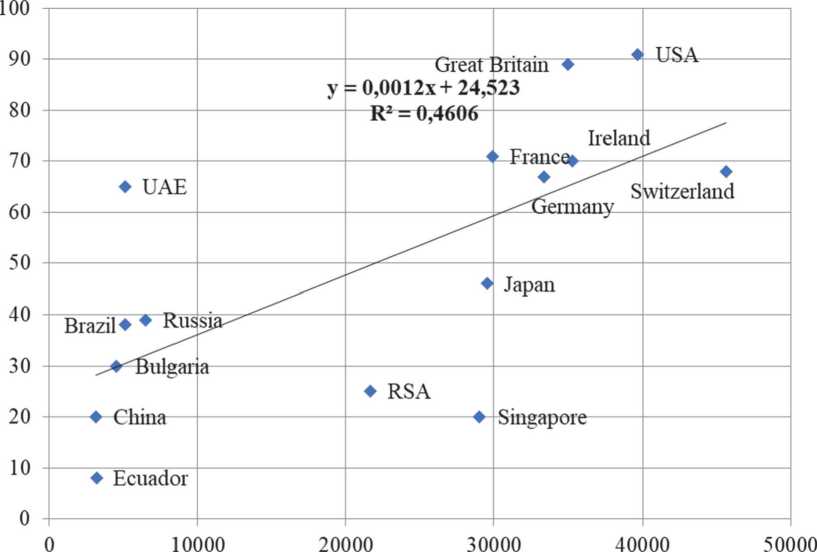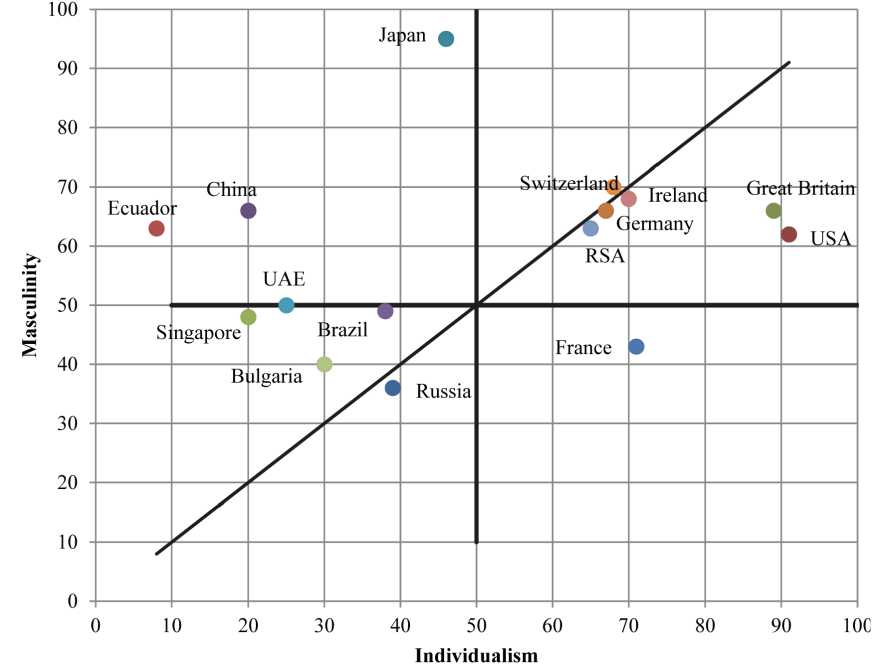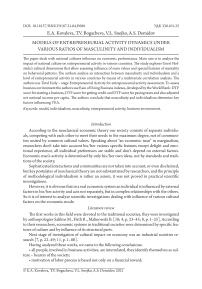Models of entrepreneurial activity dynamics under various ratios of masculinity and individualism
Автор: Kovaleva E.A., Bogacheva T.V., Snejko V.L., Demidov A.S.
Рубрика: Управление сложными системами
Статья в выпуске: 4, 2021 года.
Бесплатный доступ
The paper deals with national cultures influence on economic performance. Main aim is to analyze the impact of national culture on entrepreneurial activity in various countries. The study explores Geert Hof-stede’s cultural dimensions that allow assessing influence of main values and special features of mentality on behavioral patterns. The authors analyze an interaction between masculinity and individualism and a level of entrepreneurial activity in various countries by means of a multivariate correlation analysis. The authors use Total Early - stage Entrepreneurial Activity for entrepreneurial activity assessment. To assess business environment the authors use Ease of Doing Business indexes, developed by the World Bank: DTF score for starting a business, DTF score for getting credit and DTF score for paying taxes and also adjusted net national income per capita. The authors conclude that masculinity and individualism determine key factors influencing TEA.
Model, individualism, masculinity, entrepreneurial activity, business environment
Короткий адрес: https://sciup.org/148323538
IDR: 148323538 | УДК: 330.101.22 | DOI: 10.18137/RNU.V9187.21.04.P.088
Текст научной статьи Models of entrepreneurial activity dynamics under various ratios of masculinity and individualism
According to the neoclassical economic theory our society consists of separate individuals, competing with each other to meet their needs to the maximum degree, not of communities united by common cultural values. Speaking about “an economic man” in marginalism, researchers don’t take into account his/her various specific features except delight and emotional experience, all individual preferences are stable and don’t depend on external factors. Economic man’s activity is determined by only his/her own ideas, not by standards and traditions of the society.
Sophisticated interactions and communities are not taken into account, or even disclaimed, but key postulates of neoclassical theory are not substantiated by researchers, and the principle of methodological individualism is rather an axiom, it was not proved in practical scientific investigations.
However, it is obvious that in a real economic system an individual is influenced by external factors in his/her activity and acts not separately, but in complex relationships with the others. So it is of interest to analyze scientific investigations dealing with influence of various cultural factors on the economic mode.
Literature review
The first works in this field were devoted to the traditional societies, they were investigated by anthropologies Sahlins M., Firth R., Malinowski B. [10; 4, p. 23–45; 8, p. 1–25]. According to their researchers, economic systems in traditional societies were determined by specific features of culture and by influence of its structural parts.
Next stage of investigation of cultural impact on economy was an industrial societies research [7, p. 22–49; 11, p. 1–80].
Having analyzed these works, we came to the following conclusions:
-
• all people, involved in business activities, are interrelated, they identify themselves as culture – bearers of the society;
-
• motivation of labor process is based not only on a financial reward;
Models of entrepreneurial activity dynamics under various ratios of masculinity ...
Ковалева Екатерина Александровна кандидат экономических наук, доцент, доцент департамента инновационного бизнеса в отраслях промышленности. Инженерная академия, Российский университет дружбы народов, Москва. Сфера научных интересов: управление корпоративной культурой, управление инновациями. Автор более 40 опубликованных научных работ.
-
• national culture reflects in the economy.
It is obvious that all these statements require a statistical demonstration. Unfortunately, there is a lack of scientific investigations devoted to the statistical research of culture’s impact on the economies. From our point of view, there are several reasons for it, first, national culture is not homogeneous, even in the hedges of one country it is very difficult to find out a culturally homogenous society. Second, national culture is a very sophisticated phenomenon with a large number of structural elements, so it is very difficult to emphasize an impact of a definite cultural element on one or another economic index.
However, in spite of the difficulties presented above, there are some scientific researchers, devoted to this topic.
One of the founders of national cultures research and their influence on entrepreneurs activity was G. Hofstede, a Dutch specialist in cross-cultural management, he emphasized 6 cultural dimensions – power distance, individualism, masculinity, uncertainty avoidance, long term orientation and indulgence [6]. According to his investigation, all these dimensions are determined by national mentality and constant.
Using these dimensions, Hofstede assessed national cultures’ influence on the values of companies’ corporate cultures that in their turn determined behavior of people, working there.
According to Hofstede’s theory, individualism correlates with a level of prosperity (GDP per capita). Countries with developed economies are characterized by high scores of individualism. Masculinity and femininity reflect what social values dominate in the society men’s or women’s ones. Power distance shows people’s attitude to various kinds of inequality in the society. Scientific followers of Hofstede were Shane, Kolvereid, Westhead, Mitchell, Smith, Sea-wright, Morse and others.
Shein found out that innovative activity was initiated by the cultures with high scores of individualism and masculinity and low scores of power distance and uncertainty avoidance [12, p. 29–46; 13, p. 59–73; 14, p. 25–41]. The follow-up studies of Shein, Kolvereid and Westhead identified four cultural characteristics, motivating entrepreneurs to start their own business – need for independence from the others (in fact, individualism), development and study, need for recognition of their achievements and perception of their responsibilities. Mitchell, Smith, Seawright and Morse thought that key characteristics, encouraging entrepreneurial activity were individualism and power distance [9, p. 974–993].
So, in our work we will analyze individualism and masculinity as key cultural dimensions, influencing entrepreneurial activity.
Methology of the research
We use statistical data for the period from 2012 till 2019 for 15 countries: Russia, The USA, Great Britain, China, Japan, Germany, France, Ecuador, Singapore, Brazil, United Arab Emirates, Switzerland, Republic of South Africa, Ireland and Bulgaria.
The methods of the research are a mathematical apparatus of theory of probability and mathematical statistics, in particular, multidimensional analysis. We use application program packages “Statistica” and “Data Analysis” MS Excel.
To achieve the goal of our research we should fulfill the following tasks:
-
• to check statistical significance of an association between adjusted net national income per capita and cultural dimension “individualism” for the nine-year –period and to create regression models of these associations;
-
• to analyze a factorial space “Masculinity – Individualism” to group the countries according to specific features of national cultures;
-
• to check statistical significance of an association between factors, influencing TEA and to create models of these associations.
Results and discussions
A factorial space “Adjusted net national income per capita – Individualism”, created on the basis of statistic data of 2019, is presented in Figura 1.
Models of entrepreneurial activity dynamics under various ratios of masculinity ...

Adjusted net national profit per capita (constant 2005 SUSA)
Figura 1. An association between cultural dimension “individualism” and adjusted net national income per capita [1–3]
A r -value is 0.68, it is rather large, it allows creating a regression model, connecting individualism and national income:
I = 0.012 • ANNIPC + 24.523, (1)
where I – individualism; ANNIPC – adjusted net national income per capita.
The model is significant according to Fisher LSD ( F = 0.005). Coefficients of the equation are significant according to Student t -test ( p = 0.019 and 0.005 respectively), significance level is equal to 5 %.
Analogous models were created for each year of the analyzed period. We considered individualism as a constant index, adjusted net national income per capita changed annually. The models turned out to be sufficient and statistically significant. A slope ratio of the regression equation almost has not changed during the researched period (has fallen in the range 0.011 … 0.012).
When adjusted net national income per capita increases by 1000 USA$, individualism is 12 scores higher. It proves Hofstede’s theory about predominance of individualistic cultures in the countries with high income and predominance of collective cultures in countries with low income. In spite of the limited sampling data, a slope ratio in the model (1) has the same order as in Hofstede’s research. Variability of the coefficients is explained by a small sample number and by income dynamics in the countries.
A factorial space “Masculinity – Individualism” is presented in Figura 2.
The authors divided the factorial space into four clusters by right lines parallel to the axis of reference. 50 is considered as an average indicator value, values higher than an average value is considered to be high, lower than an average value – low. The values close to average ones (with deviation within limits of 5 scores higher or lower) are moderate. It allows pooling the researched countries (Table 1).
Table 1
Pooling of the countries according to the ratio of individualism and masculinity
|
Conditions of data typing |
Countries |
|
High individualism and masculinity |
The USA, Great Britain, Ireland, Germany, Switzerland, Republic of South Africa |
|
High individualism and moderate masculinity |
France |
|
Low individualism and masculinity |
Russia, Bulgaria |
|
Low individualism and moderate masculinity |
Singapore, UAE, Brazil |
|
Moderate individualism and high masculinity |
Japan |
|
Low individualism and high masculinity |
Ecuador, China |

Figura 2. A factorial space “Individualism – Masculinity” [3]
Right lines with various slope ratios allow determining countries with almost equal masculinity and individualism scores. Countries with high scores of individualism and masculinity are the USA, Great Britain, Ireland, Germany, Switzerland and Republic of South Africa. Russia belongs to the group of countries with low masculinity and individualism scores.
To assess how business environment influences TEA in each researched country, we use a multiregression model:
y = a 1 x 1 + a 2 x 2 + a 3 x 3 + a 4 x 4 , (2)
where a i – empirical coefficients, that should be calculated on the basis of the statistic data; х 1 – DTF score for starting a business; х 2 – DTF score for getting credit; х 3 – DTF score for paying taxes, х 4 – adjusted net national income per capita.
Correlation matrices allow determining factors х i , which influence on TEA is statistically significant (α = 90 %). We used Student t -test to assess significance of partial correlation coefficients for a small sample.
Models of entrepreneurial activity dynamics under various ratios of masculinity ...
х 3 (DTF score for paying taxes) influence on TEA is statistically significant in the countries with masculinity scores lower than an average index value, the association is noticeable х 1 (DTF score for starting a business) and х 4 (adjusted net national income per capita) influence TEA in the countries with masculinity scores higher than an average index value, the association is strong.
Unfortunately, we found out multicollinearity of the factors, planned for the model. To solve this problem, we included only the factors with the highest r -values with TEA in the model 2. We excluded х 2 (DTF score for getting credit) from the model, since its association with TEA is not statistically significant in most countries and this factor very often correlated with adjusted net national income per capita. We did not create models for Bulgaria, Singapore and UAE because of no sufficiency of the given data.
The regression models, created on the basis of our analysis, are statistically significant (Table 2) – the coefficient of determination is more than 0.9; the models are significant according to Fisher LSD (F is lower than 0.05); the regression coefficient is significant according to Student t -test ( р values are lower than 0.05).
Table 2
Pooling of TEA factor models
|
Masculinity scores |
Country |
Regression model |
Masculinity/Individualism |
R 2 |
|
50 and lower |
France |
TEA = 0,07 х 3 |
1 |
0.98 |
|
Russia |
TEA = 0,06 х 3 |
4 |
0.98 |
|
|
Brazil |
TEA = 0,36 х 3 |
9 |
0.98 |
|
|
Higher than 50 |
The USA |
TEA = 0,20 х 1 |
2 |
0.96 |
|
Great Britain |
TEA = 0,08 х 1 |
3 |
0.94 |
|
|
Republic of South Africa |
TEA = 0,10 х 1 |
5 |
0.96 |
|
|
Ireland |
TEA = 0,08 х 1 |
6 |
0.99 |
|
|
Germany |
TEA = 0,06 х 1 |
7 |
0.98 |
|
|
Switzerland |
TEA = 0,08 х 1 |
8 |
0.98 |
|
|
Japan |
TEA = 0,05 х 1 |
12 |
0.96 |
|
|
China |
TEA = 0,25 х 1 |
14 |
0.95 |
|
|
Ecuador |
TEA = 0,39 х 1 |
15 |
0.93 |
Conclusions
We put in correspondence the factorial space “Individualism – Masculinity”, divided into clusters, and the regression models, and came to the following conclusions.
Masculinity determines key factors influencing TEA – DTF score for starting a business or DTF score for paying taxes. According to the masculinity scores, TEA can be described by the regression model with a high degree of confidence.
For the countries with moderate and low masculinity, TEA model is the following:
TEA=ax3, where х3 – DTF score for paying taxes.
For the countries with high masculinity, we have the following TEA model:
TEA= ax1 , where х1 – DTF score for starting a business.
According to our analysis of the countries, a coefficient of regression in TEA models does not depend only on masculinity, but also on individualism.
For the countries with moderate and low masculinity, the higher individualism is, the stronger influence of х 3 on TEA is.
For the countries with high masculinity, the higher individualism is, the stronger influence of х 1 on TEA is.
Список литературы Models of entrepreneurial activity dynamics under various ratios of masculinity and individualism
- Adjusted net national income per capita. Date Views 3.09.2021. Available at: https://data.worldbank.org/indicator/NY.ADJ.NNTY.KD?locations=XE
- Adjusted net national income per capita. Date Views 3.09.2021. Available at: https://www.indexmundi.com/facts/indicators/NY.ADJ.NNTY.PC.KD
- Compare countries. Date Views 3.09.2021. Available at: https://www.hofstede-insights.com/product/compare-countries
- Firth, R. (1956) Human types: An introduction to social anthropology. New American Library, pp. 23-45.
- GEM Global Entrepreneurship Monitor. Date Views 3.09.2021. Available at: http://www.gemconsortium.org
- Hofstede G. (2001) Culture’s Consequences: Comparing Values, Behaviors, Institutions, and Organizations Across Nations. Second Edition, Thousand Oaks CA: Sage Publications.
- Huntington S.P., Samuel P. (2010) The Clash of Civilisations? Foreign Affairs, 72 (3), pp. 22-49.
- Malinowski B. (1922) Introduction: The subject, method and scope of the inquiry. In Argonauts of the Western Pacific. Prospect Heights, IL: Waveland Press, pp. 1-25. Available at: https://doi.org/10.2307/2548181
- Mitchell R.K., Smith B., Seawright K.W., & Morse E.A. (2010) Cross-cultural cognitions and the venture creation decision. Academy of Management Journal, 43, pp. 974-993.
- Sahlins M. (1972) Stone Age Economics. Stone Age Economics. Available at: https://doi.org/10.1525/cag.1998.20.2-3.102
- Schumacher E.F. Small is beautiful. Harsper Perennial. London, Harper Perennial, pp. 1-80. Available at: https://doi.org/10.1016/0265-9646(91)90030-L
- Shane S. (1992) Why do some societies invent more than others? Journal of Business Venturing, 7, pp. 29-46.
- Shane S. (1993) Cultural influences on national rates of innovation. Journal of Business Venturing, 8, pp. 59-73.
- Shane S. (1994) Cultural values and the championing process. Entrepreneurship Theory & Practice, 18, pp. 25-41.


